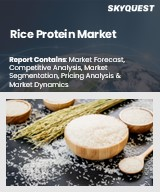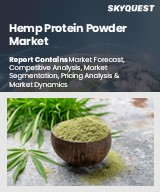
|
시장보고서
상품코드
1628275
개구리밥 단백질 시장 기회, 성장 촉진요인, 산업 동향 분석, 예측(2025-2034년)Duckweed Protein Market Opportunity, Growth Drivers, Industry Trend Analysis, and Forecast 2025 - 2034 |
||||||
2024년 7,270만 달러로 평가된 세계 개구리밥 단백질 시장은 2025년부터 2034년까지 7.9%의 CAGR로 성장할 것으로 예상됩니다.
지속가능하고 영양이 풍부한 단백질 공급원으로서 개구리밥은 식물성 단백질 산업에서 인기를 얻고 있습니다. 완전한 아미노산 프로필, 풍부한 단백질 함량, 환경에 미치는 영향이 적기 때문에 기존 단백질 공급원에 대한 매력적인 대안이 되고 있습니다. 개구리밥은 영양 보충제, 기능성 식품, 사료 등 다양한 산업 분야에서 활용되고 있습니다.
시장 확대의 주요 요인은 식물성 식단에 대한 소비자의 관심 증가, 환경 지속가능성에 대한 관심 증가, 재배 및 추출 기술의 혁신입니다. 지속적인 연구와 기술 발전으로 개구리밥 단백질은 전 세계 영양 수요를 지속적으로 충족시킬 수 있는 중요한 기업으로 자리매김하고 있습니다.
개구리밥 단백질 시장은 종에 따라 크게 두릅, 두릅, 두릅, 미역취 등으로 구분됩니다. 그 중, 콜라겐은 빠른 성장, 높은 단백질 함량, 다양한 환경 조건에 대한 적응성으로 인해 시장을 선도하는 종입니다. 바이오매스를 빠르게 두 배로 늘릴 수 있는 능력으로 인해 매우 효율적이고 자원 친화적인 단백질 공급원이 되고 있습니다. 식물성 단백질의 채택이 증가하고 지속가능한 농업 관행에 대한 수요가 증가하는 것이 이 종의 시장 지배에 기여하는 주요 요인입니다. 또한, 수경재배와 첨단 물 관리 시스템의 개발로 인해 코킥사의 대규모 생산이 강화되고 있습니다.
| 시장 범위 | |
|---|---|
| 시작 연도 | 2024년 |
| 예측 연도 | 2025-2034년 |
| 시작 금액 | 7,270만 달러 |
| 예상 금액 | 1억 5,700만 달러 |
| CAGR | 7.9% |
형태에 따라 시장은 분말, 액체, 페이스트로 구분됩니다. 분말 부문이 가장 인기가 높으며 2024년 시장 점유율은 66.3%입니다. 분말 형태의 개구리밥 단백질은 유통기한이 길고, 다양한 용도에 쉽게 적용할 수 있으며, 다재다능한 특성으로 인해 널리 사용되고 있습니다. 이 형태는 특히 음료 및 식품 산업에서 수요가 많으며, 단백질 에너지바, 쉐이크, 기능성 식품에 함유되어 있습니다. 분말의 안정성과 가벼운 무게로 인해 운송 및 보관이 용이합니다.
오리엔탈 단백질은 식품 가공 업계에서 인기를 끌고 있으며, 시장 점유율 56.9% 차지하고 있습니다. 이러한 성장의 원동력은 클린 라벨, 지속가능성, 알레르겐이 없는 식물성 식품 재료에 대한 수요에 기인합니다. 개구리밥의 완전한 아미노산 프로필과 높은 단백질 함량은 콩이나 완두콩과 같은 전통적인 단백질 공급원을 대체할 수 있는 매력적인 대안이 되고 있습니다. 또한, 지속가능한 생산 공정은 환경 친화적인 식품 제조 관행으로 전환하는 세계적인 추세에 부합합니다.
북미에서는 건강과 지속가능성에 대한 소비자의 인식이 개구리밥 단백질 시장의 성장을 견인하고 있습니다. 이 지역의 강력한 식물성 식품 부문은 단백질이 풍부하고 친환경적인 식품에 대한 수요 증가와 함께 시장 확대를 더욱 가속화하고 있습니다. 연구 진전과 식품 제조업체 및 농업 관련 기업과의 제휴는 개구리밥 단백질 생산의 확장성을 촉진하고 있으며, 향후 몇 년 동안 시장이 크게 성장할 것으로 예상됩니다.
목차
제1장 조사 방법과 조사 범위
제2장 주요 요약
제3장 업계 인사이트
- 생태계 분석
- 밸류체인에 영향을 미치는 요인
- 이익률 분석
- 파괴
- 향후 전망
- 제조업체
- 유통업체
- 공급업체 상황
- 이익률 분석
- 주요 뉴스와 대처
- 규제 상황
- 영향요인
- 성장 촉진요인
- 식물성 단백질에 대한 수요 증가
- 지속가능하고 효율적인 생산
- 영양학적 이점 개구리밥 단백질은 필수 아미노산을 모두 포함한 완전한 단백질 공급원이며, 다른 영양소도 풍부합니다.
- 업계의 잠재적 리스크와 과제
- 원료 가격 변동
- 한정된 상업적 재배 방법
- 성장 촉진요인
- 성장 가능성 분석
- Porters 분석
- PESTEL 분석
제4장 경쟁 구도
- 소개
- 기업 점유율 분석
- 경쟁 포지셔닝 매트릭스
- 전략적 전망 매트릭스
제5장 시장 추정과 예측 : 종별, 2021-2034년
- 주요 동향
- 렘나 마이너(일반적인 개구리밥)
- 스피로델라 폴리히자(큰 개구리밥)
- 울피아 글로보스
- 기타
제6장 시장 추정과 예측 : 형태별, 2021-2034년
- 주요 동향
- 분말
- 액체
- 페이스트
제7장 용도별 시장 추정과 예측 : 최종 용도별, 2021-2034년
- 주요 동향
- 식품 가공
- 동물·생선 사료
- 기타
제8장 시장 추정과 예측 : 지역별, 2021-2034년
- 주요 동향
- 북미
- 미국
- 캐나다
- 유럽
- 영국
- 독일
- 프랑스
- 이탈리아
- 스페인
- 러시아
- 아시아태평양
- 중국
- 인도
- 일본
- 한국
- 호주
- 라틴아메리카
- 브라질
- 멕시코
- 중동 및 아프리카
- 남아프리카공화국
- 사우디아라비아
- 아랍에미리트
제9장 기업 개요
- Barentz
- Bio Healthife
- Hinoman
- LemPro
- Parabel
- Plantible Foods
- SETA Organics
- Xi'an Healthway Biotech
The Global Duckweed Protein Market, valued at USD 72.7 million in 2024, is expected to grow at a CAGR of 7.9% from 2025 to 2034. As a highly sustainable and nutrient-dense protein source, duckweed is gaining traction within the plant-based protein industry. Its complete amino acid profile, rich protein content, and minimal environmental impact make it an appealing alternative to traditional protein sources. Duckweed is used in various industries, including dietary supplements, functional foods, and animal feed.
Market expansion is primarily driven by growing consumer interest in plant-based diets, increased concerns about environmental sustainability, and innovations in cultivation and extraction techniques. Ongoing research and technological advancements are positioning duckweed protein as a critical player in addressing global nutrition needs sustainably.
The duckweed protein market is segmented by species, including Lemna minor, Spirodela polyrhiza, and Wolffia globose. Among these, Lemna minor is the leading species in the market due to its rapid growth, high protein content, and adaptability to various environmental conditions. Its ability to double biomass quickly makes it a highly efficient and resource-friendly protein source. The growing adoption of plant-based proteins and the rising demand for sustainable agricultural practices are key factors contributing to the species' market dominance. Moreover, the development of hydroponic farming and advanced water management systems is enhancing the large-scale production of Lemna minor.
| Market Scope | |
|---|---|
| Start Year | 2024 |
| Forecast Year | 2025-2034 |
| Start Value | $72.7 Million |
| Forecast Value | $157 Million |
| CAGR | 7.9% |
In terms of form, the market is segmented into powder, liquid, and paste. The powder segment is the most popular, holding a market share of 66.3% in 2024. Duckweed protein in powdered form is widely used due to its longer shelf life, ease of incorporation into various applications, and versatility. This form is particularly sought after in the food and beverage industry, where it is included in protein energy bars, shakes, and functional foods. The stability and light weight of the powder form also make it easier to transport and store.
Duckweed protein is also gaining popularity in the food processing industry, which accounts for 56.9% of the market share. This growth is fueled by the demand for clean-label, sustainable, and allergen-free ingredients in plant-based food products. Duckweed's complete amino acid profile and high protein content make it an attractive alternative to conventional protein sources such as soy and pea. Furthermore, its sustainable production process aligns with the global shift toward eco-friendly food manufacturing practices.
In North America, consumer awareness of health and sustainability is fueling the growth of the duckweed protein market. The region's strong plant-based food sector, along with increased demand for protein-rich, eco-friendly foods, further accelerates market expansion. Research advancements and partnerships between food manufacturers and agricultural firms are boosting the scalability of duckweed protein production, positioning the market for significant growth in the coming years.
Table of Contents
Chapter 1 Methodology & Scope
- 1.1 Market scope & definitions
- 1.2 Base estimates & calculations
- 1.3 Forecast calculations
- 1.4 Data sources
- 1.4.1 Primary
- 1.4.2 Secondary
- 1.4.2.1 Paid sources
- 1.4.2.2 Public sources
Chapter 2 Executive Summary
- 2.1 Industry synopsis, 2021-2034
Chapter 3 Industry Insights
- 3.1 Industry ecosystem analysis
- 3.1.1 Factor affecting the value chain
- 3.1.2 Profit margin analysis
- 3.1.3 Disruptions
- 3.1.4 Future outlook
- 3.1.5 Manufacturers
- 3.1.6 Distributors
- 3.2 Supplier landscape
- 3.3 Profit margin analysis
- 3.4 Key news & initiatives
- 3.5 Regulatory landscape
- 3.6 Impact forces
- 3.6.1 Growth drivers
- 3.6.1.1 Rising demand for plant-based proteins
- 3.6.1.2 Sustainable and efficient production
- 3.6.1.3 Nutritional benefits duckweed protein is a complete protein source, containing all essential amino acids, and is rich in other nutrients
- 3.6.2 Industry pitfalls & challenges
- 3.6.2.1 Price volatility of raw material
- 3.6.2.2 Limited commercial cultivation practices
- 3.6.1 Growth drivers
- 3.7 Growth potential analysis
- 3.8 Porter's analysis
- 3.9 PESTEL analysis
Chapter 4 Competitive Landscape, 2024
- 4.1 Introduction
- 4.2 Company market share analysis
- 4.3 Competitive positioning matrix
- 4.4 Strategic outlook matrix
Chapter 5 Market Estimates & Forecast, By Species, 2021-2034 (USD Million) (Kilo Tons)
- 5.1 Key trends
- 5.2 Lemna minor (common duckweed)
- 5.3 Spirodela polyrhiza (great duckweed)
- 5.4 Wolffia globose
- 5.5 Others
Chapter 6 Market Estimates & Forecast, By Form, 2021-2034 (USD Million) (Kilo Tons)
- 6.1 Key trends
- 6.2 Powder
- 6.3 Liquid
- 6.4 Paste
Chapter 7 Market Estimates & Forecast, By End Use, 2021-2034 (USD Million) (Kilo Tons)
- 7.1 Key trends
- 7.2 Food processing
- 7.3 Animal & fish feed
- 7.4 Others
Chapter 8 Market Estimates & Forecast, By Region, 2021-2034 (USD Million) (Kilo Tons)
- 8.1 Key trends
- 8.2 North America
- 8.2.1 U.S.
- 8.2.2 Canada
- 8.3 Europe
- 8.3.1 UK
- 8.3.2 Germany
- 8.3.3 France
- 8.3.4 Italy
- 8.3.5 Spain
- 8.3.6 Russia
- 8.4 Asia Pacific
- 8.4.1 China
- 8.4.2 India
- 8.4.3 Japan
- 8.4.4 South Korea
- 8.4.5 Australia
- 8.5 Latin America
- 8.5.1 Brazil
- 8.5.2 Mexico
- 8.6 MEA
- 8.6.1 South Africa
- 8.6.2 Saudi Arabia
- 8.6.3 UAE
Chapter 9 Company Profiles
- 9.1 Barentz
- 9.2 Bio Healthife
- 9.3 Hinoman
- 9.4 LemPro
- 9.5 Parabel
- 9.6 Plantible Foods
- 9.7 SETA Organics
- 9.8 Xi'an Healthway Biotech



















